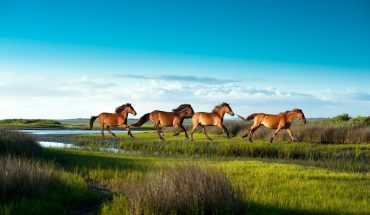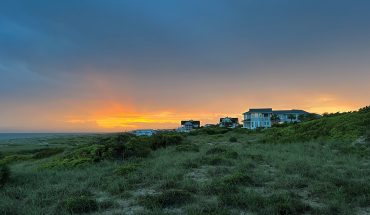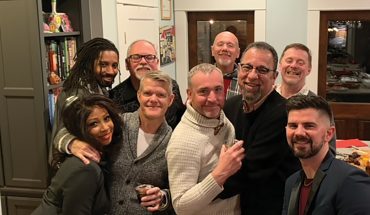A Raleigh couple takes in the wonders of the American countryside from the windows of their 33-year-old Suburban, Airstream in tow.
by Susan Garrity

On Dec. 1, my husband Jeff Basham and I, along with our Boxer, Izzy, set off on a cross-country journey, departing our home in Historic Oakwood for a planned 16-day trip to Vancouver, Canada, with no return date.
We made the trip west in our beige 1989 GMC Suburban, towing a 2011 23-foot Airstream trailer.
I mention the specifics of the vehicles because these are both, apparently, seen as “classics” by road travelers. My husband is definitely a car guy — he’s nursed our Suburban back to health on many occasions, as well as numerous MGs, Jeeps, and Miatas over the years. (In fact, the Airstream brings the total to 40 vehicles we have enjoyed together, one for each year of marriage, with only three of these bought new.) So when someone invariably rewards him at a gas stop with a comment like, How many miles do you have on that? What year is it? or I once had one just like yours, there’s instant recognition of another car guy and immediate bonding. Jeff responds to the implicit compliment with all the requested details and a head nod to their shared appreciation.

We were headed to visit one of our daughters and her husband, whom we had only seen once in over two years because of Canada’s Covid border restrictions. The motivation for purchasing the Airstream was to ultimately visit all three daughters and their families in their distant homes — Vancouver, Brooklyn, and central Kansas — for extended stays. We considered alternate means (a hotel or rental, even a towable boat), but this offered the most flexible approach to visit for a while, while maintaining our (and their) sovereignty. Seeing the country along the way would be an added bonus.
Our route from Raleigh took us due west along I-40 to Barstow, in southern California, then up 58 to Bakersfield, where we picked up Interstate 5 straight north to Canada. We had made reservations each night in advance based on five to six hours of drive time each day. We had a few longer stays worked into the schedule, where we planned to spend two or three nights.
Some friends saw this undertaking as adventurous and maybe a little bit risky. Others were envious of our spirit, curiosity, and time for an open-ended journey. We were mostly worried about the things outside our control, such as weather, traffic, other drivers, and engine failure. Having a mechanically talented spouse on board, along with great roadside insurance, assuaged that last concern.

To us, the main uncertainty had to do with space. Two people and a dog navigating a 172-square-foot interior would require dexterity, patience, and creativity — but we did share a tent one night in California, and we’d camped a couple of nights in a Volkswagen bus. Then, of course, were the years of zero personal space when the children were young.
But space, we soon learned, would not be our biggest challenge. The real hurdle was backing the trailer into an 8-foot-wide slot, bordered by other trailers, when a “pull through” space could not be procured. It’s an unintuitive, acquired skill best attempted in daylight — and our first try was not under these conditions.
We arrived late in Bentonville, Arkansas, in total darkness. After finally finding our slot, we began the process of parking. Armed with a walkie-talkie so I could guide Jeff — Driver side left a couple of inches. No, a little to the passenger side. Pull up a little. No, let’s try that again. — we were probably 20 minutes into the process when the neighbors on either side emerged to help us, perhaps fearful their trailers might become casualties. One was a first-timer, too, so he could only offer moral support, but the other was an experienced traveler and had some helpful tips: Hand on the bottom of the steering wheel, small forward and reverse moves. Success!

Bentonville was the first place we explored. There, the Crystal Bridges Museum of American Art is nestled into 120 acres of Ozark Forest, with unique architecture, a Frank Lloyd Wright-designed home, and the North Forest Light Show, an immersive walk through the evening woods amid a sound and light mosaic.
We planned a three-day stay in Albuquerque, New Mexico, with excursions to Taos and Santa Fe. Native American, Hispanic, and Latinx cultural influences are visible in every part of the city. Simply trying the different cuisines was a memorable experience. We also enjoyed the Indian Pueblo Cultural Center, particularly its exhibit Heritage: Pueblo Women Paving Cultural Pathways, representing influential women of the 19 pueblos in New Mexico and their role in the tribe’s matriarchal society. Taos abounds in Native American art and jewelry, surrounded by a landscape of high desert. Here, one heartstopping excursion was the Rio Grande Gorge Bridge, the 10th-highest bridge in the United States: as you approach it, the road suddenly gives way to a drop of 600 feet with rushing water below it. Traversing this gorge is a test of whether you are afraid of heights or not. I did not cross the bridge, nor get close enough to take a picture. Caught up in the wonders of Albuquerque and Taos, we never made it to Santa Fe.

Our next stop was Williams, Arizona, where we found ourselves snowed in and unable to tour the south rim of the Grand Canyon as planned. We did, however, take a three-hour detour to see Lower Antelope Canyon in Arizona on the reservation of the Navajo people. Words and photographs are inadequate to describe the beauty of this canyon sculpted by thousands of years of water and wind. We were fortunate to have a Navajo guide who spoke not only of the canyon’s impressive features but the ways in which the patterns in the canyon are represented in their art. On the way back, we visited the Cameron Trading Post and Gallery, where hundreds of years of Navajo antiquities are displayed.
While each of our stops held its attractions, the countryside itself is what most fascinated Jeff and me. Most of my pictures were taken through the windshield as we passed through majestic scenes of plains, prairie, mountains, forests, and valleys — the images never coming close to capturing their majesty. The vastness of our country is hard to absorb. I’ve flown over some of these areas and felt a similar sense of wonder, but the ground view is different: you see yourself in relation to the magnitude of what is before you in a very powerful and sensory way. You feel awe, and you also feel very small.

Traveling this way also exposed us to a diversity of mobile lifestyles. We engaged with others at campsites, gas stations, and rest areas, learning what pulled them to live on the road. For some, it is a permanent retirement plan of continuously traveling North America’s byways; for others it was a part-time avocation with a permanent base somewhere. Still others were following a migratory pattern — south in winter and north in summer — and for a few it solved a long-distance commute by camping near their workplace during the week and returning to a traditional home on weekends. Families, singles, young and old, retired and employed, blue-collar workers and executives, and pets were all part of this travel experience. But everyone seemed to have a well-developed sense of adventure, goodwill, and a detachment from permanence. At a gas pump in the southwest a man dressed in ranch attire took a look at the Suburban-Airstream duo and said to Jeff, “Man, I saw you coming off the exit and thought to myself, you are living the dream.” It seemed to us that the dream he referenced was also his.
As we waited in line at the Canadian border, we were impatient to finish our journey — just an hour to go! But as we pulled away from customs, we heard an ominous engine cough, followed by a bucking movement, then silence. The roadside assistance insurance was put in play and in a couple of hours we were at our daughter’s home, with the hitherto-infallible Suburban in a repair shop, much to Jeff’s dismay. (Fortunately, it was fixed.)

We are looking forward to the return trip. We will probably take a more meandering approach this time; we still want to see the Grand Canyon and maybe retrace our steps to Taos, and we would like to spend more time touring and less time “making time.” Of course, we will be glad to be home again, sitting on the front porch greeting neighbors. Jeff is eager to get back to building the 1955 MG ZA Magnette sedan in the garage. We aren’t sure about Izzy’s attitude toward the trip, but we think she’d prefer to just get home. She loves to ride in a car, but every day for her was Groundhog Day: we drove for hours, only to return to the same place.
This trip opened up new awareness for us. We are not bound to a single home life. Our neighbors are not just the folks next door, but anyone we find ourselves next to for the night. How can we help? is always welcomed. And seeing is one thing; experiencing it is another. We’re grateful that we said yes to this experience.
_
This article was originally published in the February 2022 issue of WALTER magazine



